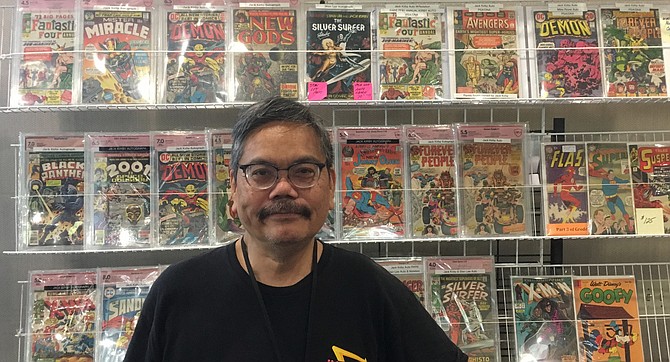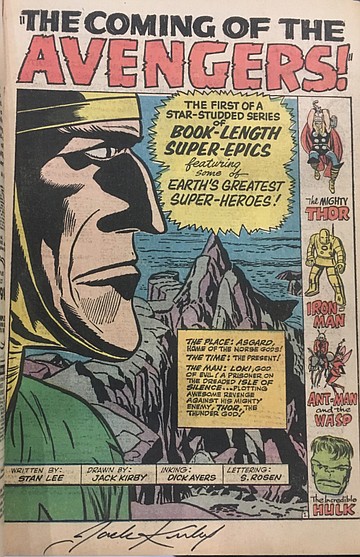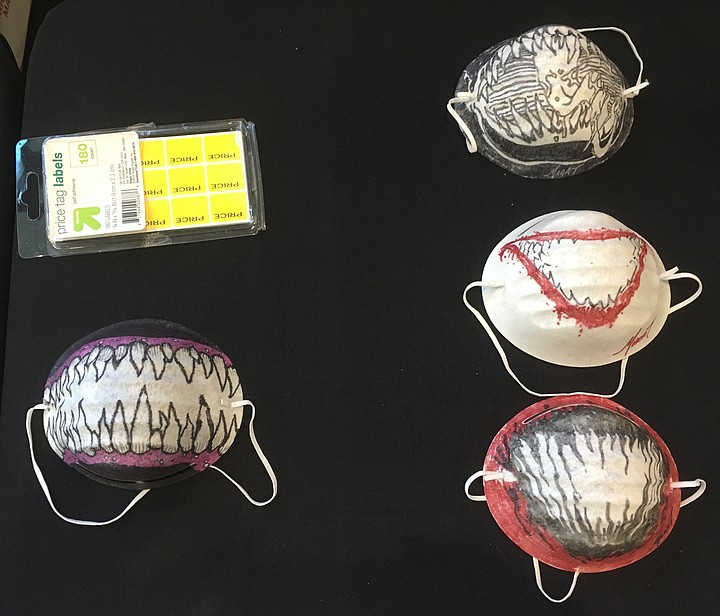 Facebook
Facebook
 X
X
 Instagram
Instagram
 TikTok
TikTok
 Youtube
Youtube

I spotted the poster for the 2020 San Diego Comic Fest during a visit to Gelato Vero last December. Or rather, I spotted Bill Sienkiewicz’s name on the poster; he was to be this year’s guest of honor at “the friendly, intimate comic convention” held at the Four Points Sheraton on Aero Drive. I was impressed. Sienkiewicz blew up the comics scene in the mid-‘80s, right as my love for the medium was peaking. I spent an absurd amount of teenaged time studying his painterly, semi-surreal work in Elektra: Assasin and The New Mutants. I studied it because it didn’t look like anything I’d ever seen, and because it made me feel something: a thrilled fascination, a sense of expanded possibilities.

Further, I had just discovered his miniseries starring The Shadow — the olde-timey superhero who served as the template for Batman. I grew up on recordings of The Shadow’s 1930s radio show, thanks to my older brother’s cassette tape collection. (On some episodes, Orson Welles provided the voice of the invisible crusader; this was before he moved to Hollywood and made Citizen Kane.) I got it into my head that it would be so, so cool to get Sienkiewicz to do a sketch of The Shadow and then give it to my brother. I didn’t know how much it would cost. I had seen a detailed sketch cover on eBay for $999, and I wondered what $200 would get me. It seemed a lot, but it represented a lot of love: for the artist, for the character, for my brother, for our shared memory of youth.
I stopped by the Comic Fest on its first full day, March 6. Sienkiewicz wasn’t there, though people said he would be, despite the growing concern over coronavirus. The Fest’s other big get for the year, prolific comic writer/screenwriter/novelist J. Michael Straczynski, had pulled out, and several exhibitors had posted signs forbidding handshakes. In the men’s room, attendees complained about the lack of hot water as they washed their hands. Over in the exhibitor hall, comic vendor Stan Agbulos was selling artist-decorated facemasks for $50: a couple of Venoms, a Carnage, and a Joker smile. “I sold three in Hawaii,” he told me. “I’d been seeing a lot of young kids wearing cloth masks with designs on them, and I thought, ‘Why not have individual pieces of artwork?’ Every time people see them, they’ll know exactly when they were drawn.”

Agbulos specializes in comics signed by the late Jack Kirby — the artist who teamed with writer Stan Lee to lay the foundations of the Marvel Universe. Agbulos had once worked delivering Kirby’s art from the artist’s home to Marvel’s offices, and “much of what I have here is what I had Jack sign for me for all the stuff I did.” The collection includes an Avengers #1 worth around $11,000; over half of that value is thanks to Kirby’s signature. “Nobody ever thought the comic market would be the way it is right now,” says Agbulos, who ran a comic shop in the Bonita Point Plaza before he went to med school, and who returned to sales after he retired. “Authentic Kirby autographs are hard to find, because he didn’t like to sign books, and so his wife Rosalind and his biographer Mark Evanier signed most of what’s out there. Jack had a very distinct ‘K.’ All of the autographs I sell are authenticated by either Professional Sports Authentication or CBCS.” He wishes he’d gotten Kirby to draw something for him, but he is glad to have one piece of original art: a page from Sgt. Fury and The Howling Commandos. “Jack was like, ‘You want the Howlers? You don’t want Thor?’ But it’s like anything else: you collect what you like.”

Sienkiewicz arrived just in time to sit for a 5 pm conversation with comic book culture chronicler Rob Salkowitz. He had been battling a deadline for, wouldn’t you know it, a comic book project. “I was going to do four pin-ups, and I turned it into a 10-page story,” he explained. “If anything, it made me fall in love with the medium all over again.” All over again? Later in the discussion, he said that he pursued his decidedly non-superhero project Stray Toasters because, after growing up on comics, “I don’t want to say I was bored or had been there done that, but I didn’t feel like I necessarily wanted to recreate what I had read. I wanted to sort of take [the medium] to what worked for me…Toasters was a chance to play with everything that I had fallen in love with, more about abstraction and emotion than pictorial illustrative narrative… ‘Here’s a chance to really break out of the perception of what comics can be.’”
After the chat ended, Sienkiewicz stepped out into the lobby to sign some items for the devoted. The line was long and patient, but I didn’t last much past the first fellow. He’d had reason to wait since before the Fest started at 10 am: a pile of Sienkiewicz comics with covers in need of both signature and illustrative embellishment via silver paint pen. When the artist finished, his admirer picked up his pile of comics and put down what looked like a pile of hundreds.
As I drove home, I talked — into my tape recorder, but at myself. “You don’t get childhood back by paying $100 for the Star Wars Death Star playset you had when you were a kid.” (Yes, I had it; yes, it was for sale at Comic Fest.) “And you don’t get it back by paying $200 for a sketch of something that mattered to you a long time ago. You don’t get childhood back. You don’t even get the feeling back. You get a memory of the feeling. That’s why they call it nostalgia” — a mash-up of the Greek for “pain” and “return home.” Because like the man says, you can’t go home again.


I spotted the poster for the 2020 San Diego Comic Fest during a visit to Gelato Vero last December. Or rather, I spotted Bill Sienkiewicz’s name on the poster; he was to be this year’s guest of honor at “the friendly, intimate comic convention” held at the Four Points Sheraton on Aero Drive. I was impressed. Sienkiewicz blew up the comics scene in the mid-‘80s, right as my love for the medium was peaking. I spent an absurd amount of teenaged time studying his painterly, semi-surreal work in Elektra: Assasin and The New Mutants. I studied it because it didn’t look like anything I’d ever seen, and because it made me feel something: a thrilled fascination, a sense of expanded possibilities.

Further, I had just discovered his miniseries starring The Shadow — the olde-timey superhero who served as the template for Batman. I grew up on recordings of The Shadow’s 1930s radio show, thanks to my older brother’s cassette tape collection. (On some episodes, Orson Welles provided the voice of the invisible crusader; this was before he moved to Hollywood and made Citizen Kane.) I got it into my head that it would be so, so cool to get Sienkiewicz to do a sketch of The Shadow and then give it to my brother. I didn’t know how much it would cost. I had seen a detailed sketch cover on eBay for $999, and I wondered what $200 would get me. It seemed a lot, but it represented a lot of love: for the artist, for the character, for my brother, for our shared memory of youth.
I stopped by the Comic Fest on its first full day, March 6. Sienkiewicz wasn’t there, though people said he would be, despite the growing concern over coronavirus. The Fest’s other big get for the year, prolific comic writer/screenwriter/novelist J. Michael Straczynski, had pulled out, and several exhibitors had posted signs forbidding handshakes. In the men’s room, attendees complained about the lack of hot water as they washed their hands. Over in the exhibitor hall, comic vendor Stan Agbulos was selling artist-decorated facemasks for $50: a couple of Venoms, a Carnage, and a Joker smile. “I sold three in Hawaii,” he told me. “I’d been seeing a lot of young kids wearing cloth masks with designs on them, and I thought, ‘Why not have individual pieces of artwork?’ Every time people see them, they’ll know exactly when they were drawn.”

Agbulos specializes in comics signed by the late Jack Kirby — the artist who teamed with writer Stan Lee to lay the foundations of the Marvel Universe. Agbulos had once worked delivering Kirby’s art from the artist’s home to Marvel’s offices, and “much of what I have here is what I had Jack sign for me for all the stuff I did.” The collection includes an Avengers #1 worth around $11,000; over half of that value is thanks to Kirby’s signature. “Nobody ever thought the comic market would be the way it is right now,” says Agbulos, who ran a comic shop in the Bonita Point Plaza before he went to med school, and who returned to sales after he retired. “Authentic Kirby autographs are hard to find, because he didn’t like to sign books, and so his wife Rosalind and his biographer Mark Evanier signed most of what’s out there. Jack had a very distinct ‘K.’ All of the autographs I sell are authenticated by either Professional Sports Authentication or CBCS.” He wishes he’d gotten Kirby to draw something for him, but he is glad to have one piece of original art: a page from Sgt. Fury and The Howling Commandos. “Jack was like, ‘You want the Howlers? You don’t want Thor?’ But it’s like anything else: you collect what you like.”

Sienkiewicz arrived just in time to sit for a 5 pm conversation with comic book culture chronicler Rob Salkowitz. He had been battling a deadline for, wouldn’t you know it, a comic book project. “I was going to do four pin-ups, and I turned it into a 10-page story,” he explained. “If anything, it made me fall in love with the medium all over again.” All over again? Later in the discussion, he said that he pursued his decidedly non-superhero project Stray Toasters because, after growing up on comics, “I don’t want to say I was bored or had been there done that, but I didn’t feel like I necessarily wanted to recreate what I had read. I wanted to sort of take [the medium] to what worked for me…Toasters was a chance to play with everything that I had fallen in love with, more about abstraction and emotion than pictorial illustrative narrative… ‘Here’s a chance to really break out of the perception of what comics can be.’”
After the chat ended, Sienkiewicz stepped out into the lobby to sign some items for the devoted. The line was long and patient, but I didn’t last much past the first fellow. He’d had reason to wait since before the Fest started at 10 am: a pile of Sienkiewicz comics with covers in need of both signature and illustrative embellishment via silver paint pen. When the artist finished, his admirer picked up his pile of comics and put down what looked like a pile of hundreds.
As I drove home, I talked — into my tape recorder, but at myself. “You don’t get childhood back by paying $100 for the Star Wars Death Star playset you had when you were a kid.” (Yes, I had it; yes, it was for sale at Comic Fest.) “And you don’t get it back by paying $200 for a sketch of something that mattered to you a long time ago. You don’t get childhood back. You don’t even get the feeling back. You get a memory of the feeling. That’s why they call it nostalgia” — a mash-up of the Greek for “pain” and “return home.” Because like the man says, you can’t go home again.
Comments